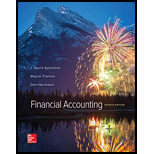
Financial Accounting
4th Edition
ISBN: 9781259307959
Author: J. David Spiceland, Wayne M Thomas, Don Herrmann
Publisher: McGraw-Hill Education
expand_more
expand_more
format_list_bulleted
Question
Chapter 9, Problem 9.15BE
1.
To determine
Bonds
Bonds are a kind of interest bearing notes payable, usually issued by companies, universities and governmental organizations. It is a debt instrument used for the purpose of raising fund of the corporations or governmental agencies. If selling price of the bond is equal to its face value, it is called as par on bond. If selling price of the bond is lesser than the face value, it is known as discount on bond. If selling price of the bond is greater than the face value, it is known as premium on bond.
To Prepare: The
2.
To determine
To Prepare: The journal entry to record first interest payment.
3.
To determine
To Explain: The reason interest expense decreases each period.
Expert Solution & Answer
Want to see the full answer?
Check out a sample textbook solution
Students have asked these similar questions
help this correct option
General Accounting
Please solve this question General accounting and step by step explanation
Chapter 9 Solutions
Financial Accounting
Ch. 9 - What is capital structure? How do the capital...Ch. 9 - Prob. 2RQCh. 9 - How do interest expense and the carrying value of...Ch. 9 - Prob. 4RQCh. 9 - What are bond issue costs? What is an underwriter?Ch. 9 - Why do some companies issue bonds rather than...Ch. 9 - Prob. 7RQCh. 9 - What are convertible bonds? How do they benefit...Ch. 9 - How do we calculate the issue price of bonds? Is...Ch. 9 - Prob. 10RQ
Ch. 9 - If bonds issue at a discount, is the stated...Ch. 9 - Prob. 12RQCh. 9 - Prob. 13RQCh. 9 - Prob. 14RQCh. 9 - 15.If bonds issue at a discount, what happens to...Ch. 9 - Prob. 16RQCh. 9 - Prob. 17RQCh. 9 - Prob. 18RQCh. 9 - 19.If bonds with a face value of 250,000 and a...Ch. 9 - Prob. 20RQCh. 9 - Prob. 9.1BECh. 9 - Prob. 9.2BECh. 9 - Calculate the issue price of bonds (LO95) Ultimate...Ch. 9 - Calculate the issue price of bonds (LO95) Ultimate...Ch. 9 - Calculate the issue price of bonds (LO95) Ultimate...Ch. 9 - Prob. 9.6BECh. 9 - Prob. 9.7BECh. 9 - Prob. 9.8BECh. 9 - Prob. 9.9BECh. 9 - Record bond issue and related annual interest...Ch. 9 - Record bond issue and related annual interest...Ch. 9 - Prob. 9.12BECh. 9 - Prob. 9.13BECh. 9 - Prob. 9.14BECh. 9 - Prob. 9.15BECh. 9 - Prob. 9.16BECh. 9 - Prob. 9.17BECh. 9 - Calculate ratios (LO98) Surfs Up, a manufacturer...Ch. 9 - Prob. 9.1ECh. 9 - Prob. 9.2ECh. 9 - Compare operating and capital teasel (LO93, LO98)...Ch. 9 - listed below are terms and definitions associated...Ch. 9 - Prob. 9.5ECh. 9 - Prob. 9.6ECh. 9 - Prob. 9.7ECh. 9 - Prob. 9.8ECh. 9 - Prob. 9.9ECh. 9 - Prob. 9.10ECh. 9 - Prob. 9.11ECh. 9 - Prob. 9.12ECh. 9 - Prob. 9.13ECh. 9 - Prob. 9.14ECh. 9 - Prob. 9.15ECh. 9 - Prob. 9.16ECh. 9 - Prob. 9.17ECh. 9 - Prob. 9.18ECh. 9 - (LO92, LO98) On January 1, 2018, the general...Ch. 9 - Record and analyze installment notes (LO92) On...Ch. 9 - Explore the impact of leases on the debt to equity...Ch. 9 - Prob. 9.3APCh. 9 - Prob. 9.4APCh. 9 - Understand a bond amortization schedule (LO96) On...Ch. 9 - Prob. 9.6APCh. 9 - Calculate and analyze ratios (LO98) Selected...Ch. 9 - Prob. 9.1BPCh. 9 - Explore the impact of leases on the debt to equity...Ch. 9 - Prob. 9.3BPCh. 9 - Prob. 9.4BPCh. 9 - Prob. 9.5BPCh. 9 - Prob. 9.6BPCh. 9 - Calculate and analyze ratios (LO98) Selected...Ch. 9 - Prob. 9.1APCPCh. 9 - Prob. 9.2APFACh. 9 - The Buckle, Inc. Financial information for Buckle...Ch. 9 - American Eagle Outfitters, Inc., vs. The Buckle,...Ch. 9 - Ethics The Tony Hawk Skate Park was built in early...Ch. 9 - Prob. 9.7APWCCh. 9 - Prob. 9.8APEM
Knowledge Booster
Learn more about
Need a deep-dive on the concept behind this application? Look no further. Learn more about this topic, accounting and related others by exploring similar questions and additional content below.Similar questions
arrow_back_ios
SEE MORE QUESTIONS
arrow_forward_ios
Recommended textbooks for you
 Excel Applications for Accounting PrinciplesAccountingISBN:9781111581565Author:Gaylord N. SmithPublisher:Cengage Learning
Excel Applications for Accounting PrinciplesAccountingISBN:9781111581565Author:Gaylord N. SmithPublisher:Cengage Learning

Excel Applications for Accounting Principles
Accounting
ISBN:9781111581565
Author:Gaylord N. Smith
Publisher:Cengage Learning
FIN 300 Lab 1 (Ryerson)- The most Important decision a Financial Manager makes (Managerial Finance); Author: AllThingsMathematics;https://www.youtube.com/watch?v=MGPGMWofQp8;License: Standard YouTube License, CC-BY
Working Capital Management Policy; Author: DevTech Finance;https://www.youtube.com/watch?v=yj-XbIabmFE;License: Standard Youtube Licence